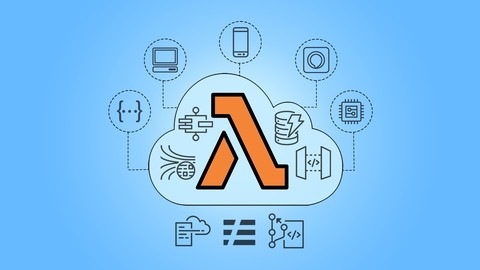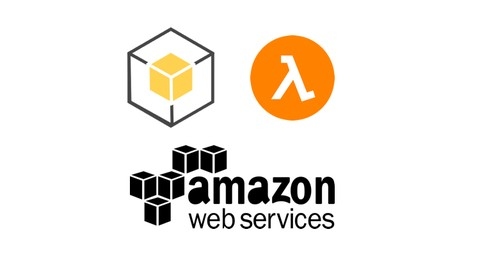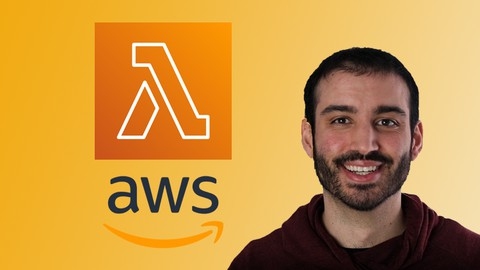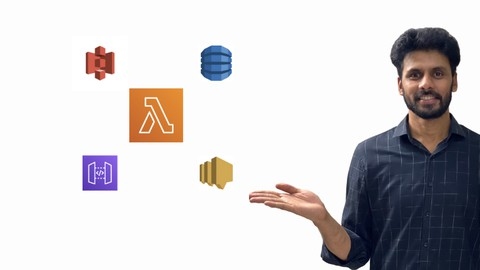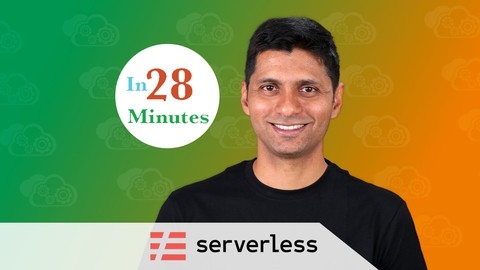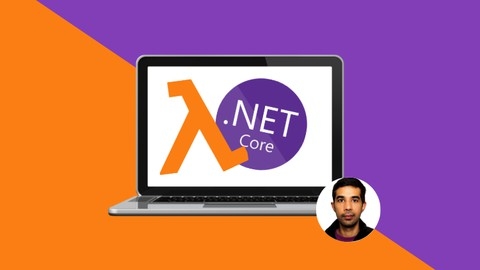AWS Lambda is a serverless computing service that allows developers to run code without provisioning or managing servers.
This is a game-changer for modern applications, enabling you to build and deploy scalable, cost-effective, and event-driven functions.
By learning AWS Lambda, you can build powerful applications, streamline your workflow, and focus on your core business logic.
Finding a good AWS Lambda course on Udemy can be a daunting task.
With so many options available, it’s easy to feel overwhelmed and unsure where to start.
You’re looking for a course that is both comprehensive and practical, offering hands-on experience with real-world projects and taught by experienced instructors.
For the best AWS Lambda course overall on Udemy, we recommend AWS Lambda & Serverless Architecture Bootcamp (Build 5 Apps).
This comprehensive program covers a wide range of topics, from the fundamentals of serverless computing to building five real-world applications.
It features hands-on projects, in-depth explanations, and expert guidance, making it an ideal choice for both beginners and experienced developers.
While this is our top pick, there are other great courses available on Udemy that cater to different learning styles and interests.
Keep reading to discover our full list of recommendations and find the perfect AWS Lambda course for your journey.
AWS Lambda and the Serverless Framework - Hands On Learning!
This course offers a robust foundation in building serverless applications on AWS, a critical skill for modern developers.
You’ll start with the fundamentals, setting up your environment and crafting your first Lambda function.
The course expertly guides you through the use of the Serverless Framework and AWS SAM CLI, simplifying the deployment and management of your serverless applications.
You’ll delve into essential concepts like configuring function timeout and memory, managing IAM permissions, and setting up environment variables.
The exploration of VPCs for Lambda functions and a clear understanding of AWS Lambda pricing will give you a solid grasp of these important aspects.
The true strength of this course lies in its practical, hands-on projects.
You’ll build a thumbnail creation service, a REST API using Python, a NodeJS-based to-do list, a contact form leveraging Amazon SES, and an email subscription service.
These projects offer real-world experience, applying the concepts you’ve learned in a practical and engaging way.
As you progress, you’ll discover the power of AWS Step Functions for creating complex workflows.
You’ll also explore EventBridge and CloudWatchEvent for scheduling events, and integrate SendGrid to handle email communications.
The course also provides valuable tips for using VS Code and the AWS Toolkit, streamlining the development and debugging processes.
AWS Lambda & Serverless Architecture Bootcamp (Build 5 Apps)
This comprehensive course will equip you with the skills to build serverless applications on AWS.
You’ll delve into core services like Lambda, API Gateway, and DynamoDB, mastering the creation of functions, deployment of APIs, and data management.
The hands-on approach ensures you gain practical skills through the development of five real-world applications.
You’ll start by grasping the fundamentals of serverless computing, understanding its benefits and challenges.
You’ll then create a simple “Hello World” API and configure your development environment.
As you progress, AWS Lambda will become your playground, exploring its features, syntax, and deployment techniques using Node.js.
Next, you’ll navigate the world of API Gateway, learning how to create endpoints, handle requests, and configure CORS.
You’ll also receive a thorough introduction to DynamoDB, encompassing data types, consistency models, and essential operations like reading, writing, and querying data.
Beyond the basics, you’ll delve into advanced concepts such as Lambda versions, aliases, and managing traffic between different versions.
Error handling, retry mechanisms, and dead letter queues (DLQs) will be demystified.
The course also integrates CI/CD tools like CodeCommit, CodeBuild, and CodePipeline, enabling you to automate your deployment process.
Throughout the journey, you’ll build five practical projects, encompassing a serverless REST API, mobile app integration, and even an Alexa skill.
You’ll learn to leverage the Serverless Framework and AWS SAM for accelerated development.
Build a Serverless App with AWS Lambda - Hands On! 2024 ed.
You’ll start with the basics, creating a static chat application using S3 to understand the foundation of serverless architecture.
You’ll then dive into the heart of serverless computing with Lambda functions, learning how to create APIs and manage access control with IAM and policies.
This is where you’ll grasp the power of serverless – creating scalable and efficient applications without managing servers.
The course seamlessly integrates DynamoDB, a robust NoSQL database, for data storage.
You’ll learn to create tables, interact with them using Lambda functions, and understand the differences between DynamoDB and S3, allowing you to make informed storage decisions.
As your application grows, you’ll break down your code into smaller, more manageable Lambda functions, and this is where API Gateway comes in.
You’ll learn how to build a robust API structure, explore API Gateway models, request flows, and stages, ensuring a flexible and scalable API for your chat application.
To add a crucial layer of security and user management, you’ll implement Cognito.
You’ll create user pools, list users, and secure your API with Cognito authorizers, ensuring user authentication is both secure and user-friendly.
The course concludes with optimization techniques like Lambda versioning and stage variables, and explores CloudFront, a content delivery network (CDN), to enhance performance and scalability.
You’ll leave the course with a deep understanding of building and deploying a secure, scalable serverless chat application, equipped to take on more complex serverless projects.
AWS - Mastering Boto3 & Lambda Functions Using Python
This course provides a comprehensive exploration of AWS, focusing on the powerful tools of Boto3 and Lambda functions.
You’ll gain a strong foundation in using Boto3, the Python library for interacting with AWS services, to manage resources like EC2 instances and EBS volumes.
You’ll also delve into AWS Lambda, the serverless compute service that empowers you to execute code without managing servers.
The course starts by laying the groundwork with Python fundamentals, guiding you through setting up your environment with Python 3.x and Pycharm IDE on Mac OS.
You’ll acquire the essential Python skills needed to perform a wide range of operations on EC2 instances, including launching, starting, stopping, and terminating them, as well as describing and filtering them.
Moving to Lambda, you’ll explore its core concepts and understand how it functions within a serverless architecture.
You’ll gain practical experience in creating, managing, and optimizing Lambda functions, learning techniques for performance tuning, memory and CPU management, and even running Lambda functions within a VPC.
You’ll also master the art of managing Lambda versions and aliases, creating deployment packages, and sending Slack notifications.
You’ll discover the power of Lambda layers for effective management of external dependencies.
You’ll learn how to pass environment variables to Lambda functions, including methods for encrypting sensitive data.
You’ll gain the ability to schedule Lambda functions, such as automatically processing JSON files uploaded to S3 and storing them in DynamoDB, or finding unused volumes and sending email notifications.
You’ll also dive into the world of DynamoDB with Boto3, exploring concepts like items, attributes, partition keys, and read and write capacity.
You’ll be equipped to perform a variety of operations in DynamoDB, including creating, getting, deleting, and batch writing items.
Finally, you’ll master S3 operations, including creating buckets, uploading and deleting files, listing objects and buckets, and even leveraging S3 Select to extract specific rows and columns from CSV files stored in S3.
This course is packed with practical examples and hands-on exercises, ensuring you gain the skills and knowledge needed to confidently leverage Boto3 and Lambda in your AWS projects.
AWS Lambda - A Practical Guide - Learn from an Expert
You’ll start by getting a solid understanding of what Lambda is and how it works, then immediately jump into hands-on activities to solidify your knowledge.
You’ll delve into essential Lambda concepts such as triggers, invocation types, and the impact of memory, pricing, and concurrency on your functions.
The “Hands On” sections are particularly valuable, allowing you to experiment with setting timeouts, handling throttling issues, and configuring versions and aliases, all of which are crucial for managing function updates.
The course goes beyond the basics, equipping you with knowledge of advanced topics like Dead Letter Queues, layers, and Docker integration.
You’ll be well-prepared to tackle complex scenarios and build robust serverless applications.
The practical projects are a great way to put your learning into practice.
You’ll get hands-on experience building a REST API with API Gateway, processing events with SQS, and integrating with Cloudwatch Events.
You’ll be well-equipped to confidently develop and deploy serverless solutions using Lambda.
Serverless using AWS Lambda for Java Developers
You’ll start by gaining a solid understanding of the core concepts of serverless computing, including Functions as a Service (FaaS) and the capabilities of AWS Lambda.
The course then dives into setting up your development environment, walking you through the process of using essential tools like AWS SAM, AWS CLI, and Java Maven.
You’ll learn how to configure your preferred IDE (Eclipse or Visual Studio Code) and become comfortable with YAML syntax, a crucial language for defining your serverless infrastructure.
You’ll build your first serverless project from scratch, using the classic “Hello World” example to illustrate the process of building, deploying, and testing your Lambda function.
You’ll learn how to pass parameters, structure your project effectively using template.yaml and pom.xml, and even test your code locally before deployment.
The course goes beyond simple examples, teaching you how to handle various data types including lists, maps, and POJOs.
You’ll explore the Lambda context object, learn how to set environment variables, and gain a deep understanding of the concept of cold starts.
You’ll also learn how to invoke your Lambda function remotely and build serverless APIs using API Gateway.
Next, you’ll dive into integrating popular AWS services such as DynamoDB, SNS, and S3 into your serverless applications.
The course provides practical examples, demonstrating how to create APIs to interact with DynamoDB, publish messages to SNS, and implement asynchronous workflows with S3.
These hands-on exercises will solidify your understanding of how to leverage these services effectively.
The course doesn’t stop at functionality.
It also covers crucial aspects like logging and error handling.
You’ll explore various logging techniques, from basic System.out statements to using libraries like Log4j, allowing you to implement robust logging solutions.
You’ll learn best practices for error handling, including the setup of Dead Letter Queues and dedicated error handler functions.
Finally, you’ll delve into the essential aspects of scaling your serverless applications, understand the impact of cold starts, and explore how to use SQS as an event source for your Lambda functions.
This comprehensive approach provides you with a solid foundation in serverless development, equipping you with the knowledge and skills to build and deploy real-world serverless applications using AWS Lambda.
Serverless using AWS Lambda for Python Developers
You’ll gain a firm understanding of serverless architecture, its benefits, and how to leverage the power of AWS Lambda to create dynamic, scalable applications.
The curriculum starts with a solid foundation in serverless concepts and a deep dive into AWS Lambda itself.
You’ll learn how to craft your first Lambda function, explore different invocation types and modes, and master the Boto3 API for seamless interaction with other AWS services.
The course doesn’t shy away from practical considerations, covering pricing models and important factors to keep in mind as you build your serverless applications.
You’ll then embark on a journey of setting up your development environment using powerful AWS tools like AWS SAM.
This hands-on experience will guide you through creating, building, deploying, and testing your serverless projects using the AWS SAM CLI.
Passing parameters to your Lambda functions, testing locally, and understanding the intricacies of the testing process are all covered in detail.
The course goes beyond the basics, exploring various data types for your Lambda functions, including lists, dictionaries, and the context object.
You’ll master environment variable configuration, tackle the nuances of cold starts, and learn to create serverless APIs using AWS API Gateway and integrate them seamlessly with Lambda.
DynamoDB takes center stage as you discover how to store and retrieve data in your applications, while S3 empowers you to store files and trigger Lambda functions using S3 events.
You’ll explore the power of SNS for sending notifications and delve into the world of asynchronous workflows using SQS.
Logging and error handling are crucial aspects of any application, and this course covers them comprehensively.
You’ll learn how to set up dead letter queues and error Lambda functions, ensuring that your applications are robust and resilient.
The final piece of the puzzle is learning how to use SQS as an event source for your Lambda functions, further expanding your serverless toolset.
You’ll be equipped with the practical skills and knowledge necessary to build your own serverless applications, confidently navigating the AWS ecosystem using tools like AWS SAM, Boto3, and the AWS CLI.
You’ll also gain hands-on experience with essential AWS services like API Gateway, DynamoDB, S3, SNS, and SQS.
Introduction to AWS Lambda - A 2-hour Crash Course
You’ll begin by understanding the building blocks of serverless applications—microservices and containers—before delving into the core concepts of serverless computing and how Lambda fits into the picture.
The course guides you through the process of invoking Lambda functions with clear examples and demonstrations, making the concepts easily digestible.
You’ll gain a strong understanding of Lambda’s scaling capabilities, exploring unreserved, reserved, and provisioned concurrency, which are crucial for optimizing performance in different scenarios.
Get hands-on experience with the AWS Console, learning how to monitor Lambda logs and create your first Lambda function.
You’ll also learn how to integrate Lambda functions with Identity and Access Management (IAM) and Virtual Private Clouds (VPCs) for enhanced security and control.
A bonus video further reinforces the key concepts, ensuring you have a comprehensive grasp of this powerful serverless technology.
Master AWS Lambda: Go Serverless with AWS
This course expertly guides you through the fundamentals of AWS Lambda and Azure Functions, enabling you to build and deploy serverless applications on both leading cloud platforms.
You’ll start by mastering the basics of AWS, including account creation and managing user permissions with IAM.
The course then delves into the core of serverless development with AWS Lambda, guiding you through the creation of your first function and equipping you with essential monitoring tools like CloudWatch and XRay.
Next, you’ll unlock the power of API Gateway, crafting both REST and HTTP APIs to connect your serverless functions to the outside world.
This practical experience is further enhanced by a hands-on project where you build a complete REST API for managing tasks.
You’ll utilize Lambda functions, API Gateway, and DynamoDB to store your data, culminating in a functional API that can be integrated with an Angular frontend.
You’ll also explore the Azure cloud, learning to leverage Azure Functions and Azure Cosmos DB to build a similar task management API.
This dual-platform approach ensures you gain a well-rounded understanding of serverless development across the most popular cloud providers.
Finally, you’ll learn to streamline your serverless deployments using powerful tools like AWS SAM and the Serverless Framework.
These frameworks automate the creation and configuration of your Lambda functions, API Gateway endpoints, and DynamoDB tables, allowing you to focus on building exceptional applications.
You’ll be ready to embrace the flexibility, scalability, and cost-efficiency that serverless computing offers.
AWS Lambda For The .NET Developer
This course provides a comprehensive and practical introduction to building serverless applications using AWS Lambda and your .NET skills.
You’ll start by setting up your AWS account and development environment, then dive into the core concepts of writing, debugging, testing, and deploying your first .NET Lambda function.
The course goes beyond the basics, guiding you through the process of storing and managing data using Amazon DynamoDB.
You’ll learn how to connect your Lambda functions to DynamoDB, enabling you to seamlessly save and retrieve data.
This foundation will empower you to build real-world applications, and the course demonstrates this by walking you through the process of building a full-fledged API using AWS Lambda and Amazon API Gateway.
You’ll learn to create robust endpoints for common CRUD operations, a crucial skill for any modern application developer.
The course also explores the powerful world of Lambda triggers, showcasing how you can integrate your Lambda functions with other AWS services to create event-driven architectures.
You’ll learn how to use Amazon SQS and Amazon SNS to trigger Lambda functions based on specific events, making your applications more responsive and adaptable.
Finally, the course delves into the inner workings of AWS Lambda runtimes and execution environments, providing you with a deeper understanding of how your code runs on the platform.
This knowledge will give you a competitive edge when it comes to optimizing your Lambda functions for performance and efficiency.
It combines hands-on experience with a solid theoretical foundation, making it an ideal resource for both beginners and those looking to expand their skills in this exciting and rapidly growing field.


